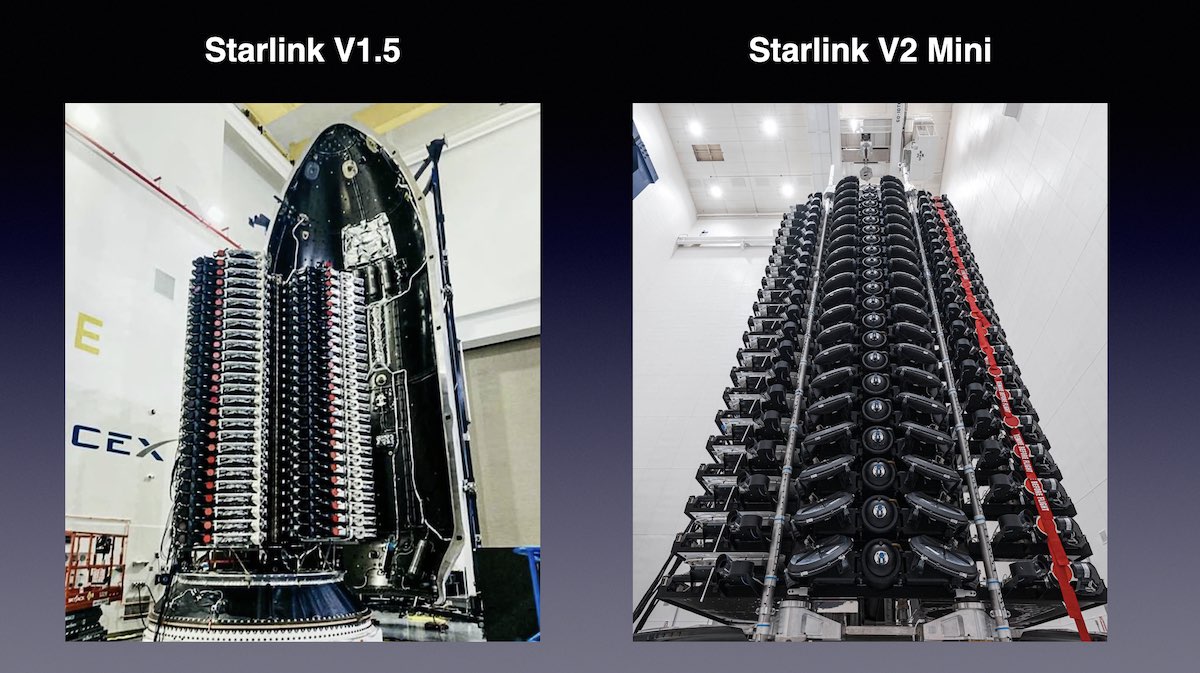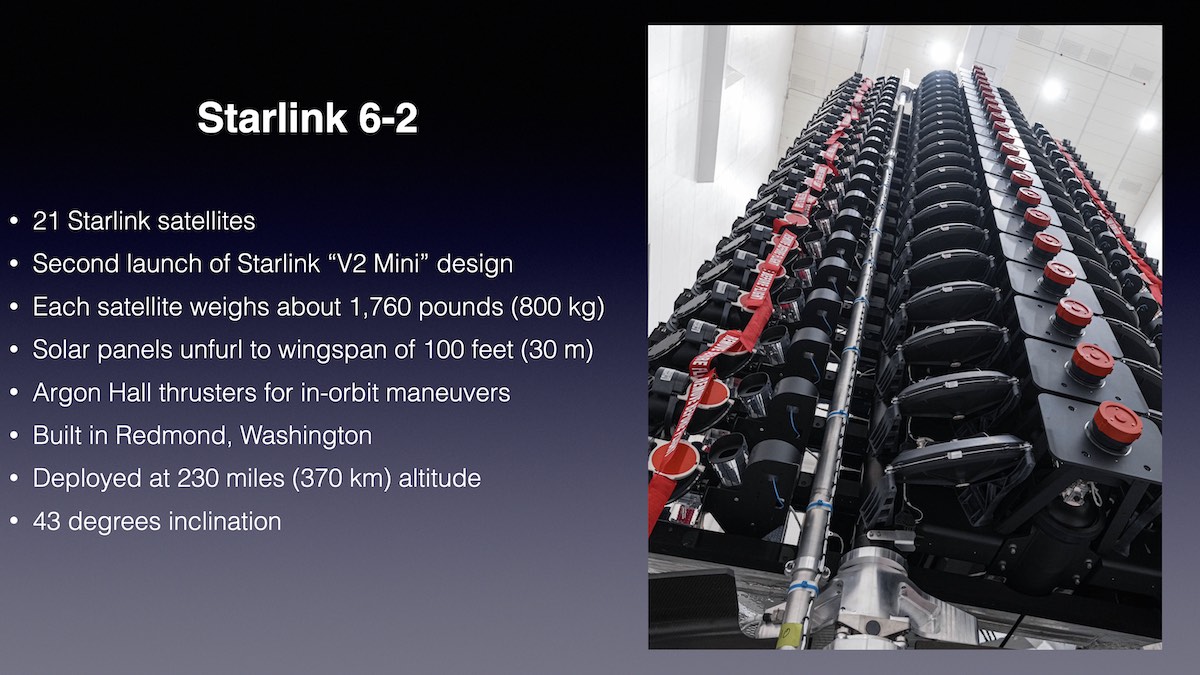Watch our live coverage of the countdown and launch of a SpaceX Falcon 9 rocket on the Starlink 6-2 mission at 9:47 a.m. EDT (1347 GMT) on April 19 from Space Launch Complex 40 at Cape Canaveral Space Force Station, Florida. Follow us on Twitter.
SFN Live
SpaceX plans to resume launches of upgraded second-generation Starlink internet satellites Wednesday from Cape Canaveral, nearly two months after some spacecraft in the first batch of larger, more capable “Starlink V2 Mini” satellites ran into problems soon after liftoff.
Liftoff of 21 second-generation Starlink V2 Mini satellites on top of a Falcon 9 rocket is set for 9:47 a.m. EDT (1347 UTC) from pad 40 at Cape Canaveral Space Force Station, the second of five instantaneous launch times available for the mission Wednesday.
There is an 85% chance of favorable weather for launch Wednesday, according to the U.S. Space Force’s 45th Weather Squadron. The main weather concerns are with ground winds and thick clouds over the launch site.
This mission, known as Starlink 6-2, will continue launching SpaceX’s new Starlink V2 Mini satellite platform fitted with improved phased array antennas with four times the communications capacity of earlier generations of Starlink satellites, known as Version 1.5, to beam internet signals to consumers around the world. Despite their name, the Starlink V2 Mini satellites are nearly times as massive and more than four times larger than the older Starlink V1.5 satellites.
The “Mini” moniker refers to SpaceX’s plans to launch an even larger full-size Starlink V2 satellite design on the company’s huge new Starship rocket. The Starship has nearly 10 times the payload lift capability of a Falcon 9 rocket, with greater volume for satellites, too.
The full-size Starlink V2s will be capable of transmitting signals directly to cell phones. But with the Starship rocket still undergoing preparations for its first test flight to space, SpaceX began launching second-generation satellites on Falcon 9 rockets and developed the V2 Minis to fit on the company’s existing launch vehicles.
The first group of 21 Starlink V2 Mini satellites launched Feb. 27 on a Falcon 9 rocket, but most of those spacecraft have not started maneuvering into SpaceX’s operational fleet. Like all Starlink launches, the Falcon 9 rocket with the first batch of Starlink V2 Mini spacecraft released the payloads into a roughly 230-mile-high (370-kilometer) orbit below their final operating altitude. The satellites were then supposed to use on-board propulsion to raise their orbits to an altitude of more than 300 miles (500 kilometers).
Elon Musk, SpaceX’s founder and CEO, tweeted the first group of Starlink V2 Mini satellites were “experiencing some issues, as expected.” SpaceX planned to thoroughly test the satellites before boosting them above the altitude of the International Space Station to their final operating orbit. Musk said some of the upgraded Starlink V2 Mini satellites on the Feb. 27 launch could be deorbited without ever entering service.
As of Wednesday, two of the first 21 Starlink V2 Mini satellites have been deorbited to re-enter the atmosphere and burn up, according to a tabulation by Jonathan McDowell, an astrophysicist and expert tracker of spaceflight activity. Three of the Starlink V2 Mini satellites appear to be ascending toward an operational altitude, and another 16 remain in a lower orbit, presumably still undergoing tests and checkouts.
While SpaceX worked out problems with the first batch of Starlink V2 Mini satellites, the company reverted to launching more batches of older-design Starlink V1.5 satellites on Falcon 9 rockets in March.
Now SpaceX appears ready to resume launching Starlink V2 Minis.

In addition to improved communications capability, the Starlink V2 Mini satellites have more efficient, higher-thrust argon-fueled propulsion systems. Argon is cheaper than the krypton gas SpaceX used to fuel ion engines on the older-generation Starlink V1.5 satellites.
“This means Starlink can provide more bandwidth with increased reliability and connect millions of more people around the world with high-speed internet,” SpaceX said before the first launch of Starlink V2 Mini satellites in February.
Each Starlink V2 Mini satellite weighs about 1,760 pounds (800 kilograms) at launch, nearly three times heavier than the older Starlink satellites. The are also bigger in size, with a spacecraft body more than 13 feet (4.1 meters) wide, filling more of the Falcon 9 rocket’s payload fairing during launch, according to regulatory filings with the Federal Communications Commission.
The larger, heavier satellite platform means a Falcon 9 rocket can only launch about 21 Starlink V2 Mini payloads at a time, compared to more than 50 Starlink V1.5s on a single Falcon 9 launch.
The two deployable solar panels on each Starlink V2 Mini satellite span about 100 feet (30 meters) tip-to-tip. The previous generation of Starlink V1.5 satellites each have a single solar array wing, with each spacecraft measuring about 36 feet (11 meters) end-to-end once the solar panel is extended.
The enhancements give the Starlink V2 Mini satellites a total surface area of 1,248 square feet, or 116 square meters, more than four times that of a Starlink V1.5 satellite.
The Federal Communications granted SpaceX approval Dec. 1 to launch up to 7,500 of its planned 29,988-spacecraft Starlink Gen2 constellation, which will spread out into slightly different orbits than the original Starlink fleet. The regulatory agency deferred a decision on the remaining satellites SpaceX proposed for Gen2.
Specifically, the FCC granted SpaceX authority to launch the initial block of 7,500 Starlink Gen2 satellites into orbits at 525, 530, and 535 kilometers, with inclinations of 53, 43, and 33 degrees, respectively, using Ku-band and Ka-band frequencies.
The FCC previously authorized SpaceX to launch and operate roughly 4,400 first-generation Ka-band and Ku-band Starlink spacecraft that SpaceX has been launching since 2019.
With the launch Wednesday, SpaceX will have flown 372 Starlink Gen2 satellites into orbit, and deployed 4,238 Starlinks satellites in all, including test units no longer in service. More than 3,900 Starlink satellites are currently in orbit, according to McDowell.

The Gen2 satellites could improve Starlink coverage over lower latitude regions, and help alleviate pressure on the network from growing consumer uptake. SpaceX says the network has more than 1 million active subscribers, mostly households in areas where conventional fiber connectivity is unavailable, unreliable, or expensive.
During Wednesday’s countdown, SpaceX’s launch team will be stationed inside a launch control center just south of Cape Canaveral Space Force Station to monitor key systems on the Falcon 9 rocket and at the launch pad. SpaceX will begin loading super-chilled, densified kerosene and liquid oxygen propellants into the Falcon 9 vehicle at T-minus 35 minutes.
Helium pressurant will also flow into the rocket in the last half-hour of the countdown. In the final seven minutes before liftoff, the Falcon 9’s Merlin main engines will be thermally conditioned for flight through a procedure known as “chilldown.” The Falcon 9’s guidance and range safety systems will also be configured for launch.
After liftoff, the Falcon 9 rocket will vector its 1.7 million pounds of thrust — produced by nine Merlin engines — to steer southeast over the Atlantic Ocean. The Falcon 9 rocket will exceed the speed of sound in about one minute, then shut down its nine main engines two-and-a-half minutes after liftoff. The booster stage will separate from the Falcon 9’s upper stage, then fire pulses from cold gas control thrusters and extend titanium grid fins to help steer the vehicle back into the atmosphere.
Two braking burns will slow the rocket for landing on the drone ship “A Shortfall of Gravitas” around 410 miles (660 kilometers) downrange approximately eight-and-a-half minutes after liftoff. The reusable booster, designated B1073 in SpaceX’s inventory, will fly on its eighth trip to space Wednesday.
The Falcon 9’s reusable payload fairing will jettison during the second stage burn. A recovery ship is also on station in the Atlantic to retrieve the two halves of the nose cone after they splash down under parachutes.
Landing of the first stage on Wednesday’s mission will occur just as the Falcon 9’s second stage engine cuts off to deliver the Starlink satellites into a preliminary parking orbit. Another upper stage burn 54 minutes into the mission will reshape the orbit ahead of payload separation.
Separation of the 21 Starlink spacecraft, built by SpaceX in Redmond, Washington, from the Falcon 9 rocket is expected about 65 minutes after liftoff.
The Falcon 9’s guidance computer aims to deploy the satellites into an orbit at an inclination of 43 degrees to the equator, with an altitude ranging between 213 miles and 219 miles (344-by-353 kilometers). After separating from the rocket, the 21 Starlink spacecraft will unfurl solar arrays and run through automated activation steps, then use their argon-fueled ion engines to maneuver into their operational orbit.
ROCKET: Falcon 9 (B1073.8)
PAYLOAD: 21 Starlink V2 Mini satellites (Starlink 6-2)
LAUNCH SITE: SLC-40, Cape Canaveral Space Force Station, Florida
LAUNCH DATE: April 19, 2023
LAUNCH TIME: 9:47 a.m. EDT (1347 GMT)
WEATHER FORECAST: 85% chance of acceptable weather; Low risk of upper level winds; Low risk of unfavorable conditions for booster recovery
BOOSTER RECOVERY: “A Shortfall of Gravitas” drone ship northeast of the Bahamas
LAUNCH AZIMUTH: Southeast
TARGET ORBIT: 213 miles by 219 miles (344 kilometers by 353 kilometers), 43.0 degrees inclination
LAUNCH TIMELINE:
- T+00:00: Liftoff
- T+01:12: Maximum aerodynamic pressure (Max-Q)
- T+02:25: First stage main engine cutoff (MECO)
- T+02:28: Stage separation
- T+02:34: Second stage engine ignition (SES 1)
- T+03:06: Fairing jettison
- T+06:08: First stage entry burn ignition (three engines)
- T+06:31: First stage entry burn cutoff
- T+08:03: First stage landing burn ignition (one engine)
- T+08:26: First stage landing
- T+08:36: Second stage engine cutoff (SECO 1)
- T+54:23: Second stage engine ignition (SES 2)
- T+54:26: Second stage engine cutoff (SECO 2)
- T+1:05:13: Starlink satellite separation
MISSION STATS:
- 218th of a Falcon 9 rocket since 2010
- 228th launch of Falcon rocket family since 2006
- 8th launch of Falcon 9 booster B1073
- 158th flight of a reused Falcon booster
- 185th SpaceX launch from Florida’s Space Coast
- 121st Falcon 9 launch from pad 40
- 176th launch overall from pad 40
- 80th Falcon 9 launch primarily dedicated to Starlink network
- 24th Falcon 9 launch of 2023
- 25th launch by SpaceX in 2023
- 18th orbital launch attempt based out of Cape Canaveral in 2023
Email the author.
Follow Stephen Clark on Twitter: @StephenClark1.
from Spaceflight Now https://ift.tt/gZhCyjo
via World Space Info







0 comments:
Post a Comment